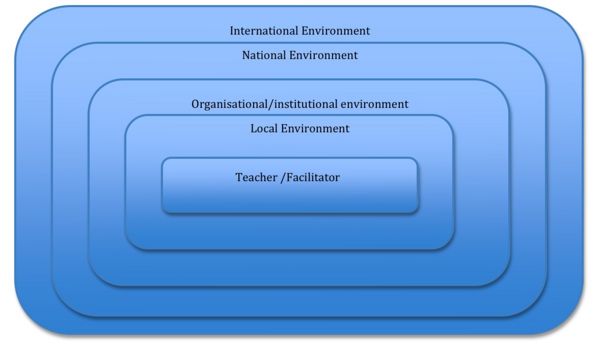Learner Centred Learning/Learning in context
Learning doesn’t occur in isolation there is always a context surrounding the learning.
This module introduces a variety of aspects relating to context and encourages you to explore ways in which you can consider the contexts within which you are facilitating learning.
| Consider:
What does context mean to you?
|
Learning outcomes
By the end of this module you will have :
- Identified ways of exploring your own teaching context
- Considered and reflected on a range of factors impacting upon your own context
- Started to think about how you can use your knowledge of your own teaching context to enhance the way you facillitate learning.
Context Defined
That which surrounds, and gives meaning to, something else.
The Free On-line Dictionary of Computing.
The set of circumstances or facts that surround a particular event, situation, etc.
Dictionary.com Unabridged (v 1.1).
Reviewing your context
Context can be viewed from the perspective of the learner, considering all the factors that influence and impact on learners in specific courses, programmes or environments.
Context can also be viewed from the perspective of the teacher/facilitator. As a teacher/facilitator it is helpful to review your own context from time to time to thus enable you to create the best possible context for learning for the learners you work with.
There are many ways in which you can review the context within which you teach. This type of review can be referred to an environmental analysis (a review of the environment within which you work). The following are some of the types of approaches that you could use:
- Brainstorm all influencing factors
- Begin by looking at job requirements and skills necessary for job
- SWOC analysis
- Systems or ripple pattern
| Brainstorm an initial description of your own teaching/facilitation context
Physically record this in some way, such as writing or drawing
|
SWOC analysis
A SWOC analysis (also referred to as a SWOT analysis), derived from management literature explores factors that characterise a particular situation under 4 main headings:
- Strengths
- Weaknesses
- Opportunities
- Challenges / Constraints / Threats
For those who are interested this link takes you to a simple guide SWOC analysis tool. Whilst written in language for a business organisation this can easily be adapted to education.
Systems Approach
A systems approach that explores influencing factors in expanding concentric circles is another way of reviewing your context.
There is often a tendency to focus on immediate surroundings without thinking about some of the wider factors that impact on our contexts. Here are some suggestions of factors that can impact on the wider environments.
Organisational Environment
- Mission, charter, profile, strategic direction, organisation philosophy, employment requirements / conditions
National Environment
- Government policy
- Tertiary Education Strategy
- TEC - Tertiary Education Commission
- Industry or Professional Body standards and requirements
International Environment
- Global issues
- Trends in adult education
- e-learning, use of social media and globalisation
| Develop your own environmental analysis by using your initial brainstorm of your own context to create a systems diagram adding the factors at each level that impact on your own teaching/facilitation context.
|
*Factors that impact upon your teaching/facilitation context are much broader than what immediately impacts upon you.
|
When you have completed this module share your thoughts and learning on the Moodle Discussion board
References
context. (n.d.). Dictionary.com Unabridged (v 1.1). Retrieved May 04, 2009, from Dictionary.com website: http://dictionary1.classic.reference.com/browse/context
context. (n.d.). The Free On-line Dictionary of Computing. Retrieved May 04, 2009, from Dictionary.com website: http://dictionary1.classic.reference.com/browse/context


